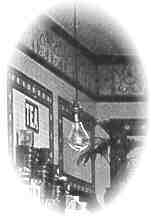![]()
Artificial light was also needed because much of the trade was done late in the evenings. John James Sainsbury's felt strongly about good lighting, indeed, his dying words in 1928 were said to have been 'Keep the shops well lit.'
 |
Recuperative gas light at Watford, c1900. |
Gas lighting
The only artificial shop lighting in the 1890s was gas. Sainsbury's used a special system called 'recuperative' gas lighting. The gas was pre-heated by circulating it over the burner before it was ignited. This was believed to reduce gas consumption. Even in the Victorian period energy conservation was important because gas was expensive.
Electric Lighting
This was first installed around 1905, consisting of a simple row of naked 40 watt light bulbs on flexes over each counter like those in the Guildford photograph. These were succeeded by more attractive single rows of lanterns down the centre of the store.
By the end of the 1914-18 war, most branches used electric lighting. Gas lighting continued to be used outside the stores well into the 1930s years so trading from the window and forecourt could continue after dark.
 |
Electric lighting at Guildford, 1906. |
Back to inside the store.
Copyright J Sainsbury plc, 2000.